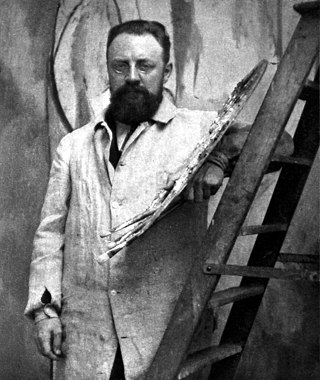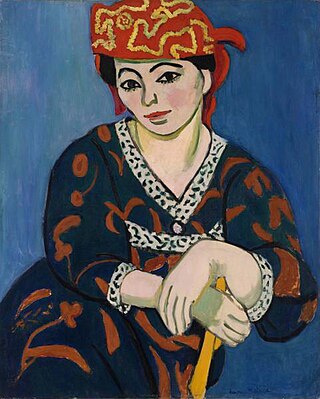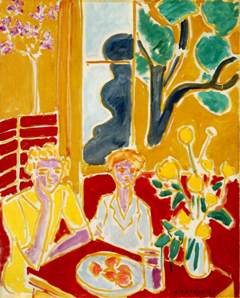
Henri Émile Benoît Matisse was a French visual artist, known for both his use of colour and his fluid and original draughtsmanship. He was a draughtsman, printmaker, and sculptor, but is known primarily as a painter. Matisse is commonly regarded, along with Pablo Picasso, as one of the artists who best helped to define the revolutionary developments in the visual arts throughout the opening decades of the twentieth century, responsible for significant developments in painting and sculpture.

Henri Matisse’s Jazz is a limited-edition art book containing prints of colorful cut-paper collages, accompanied by the artist's written thoughts. It was first issued on September 30, 1947, by art publisher Tériade. The portfolio, characterized by vibrant colors, poetic texts, and circus and theater themes, marks Matisse's transition to a new form of medium.

Madras Rouge is a painting by Henri Matisse from 1907. The woman depicted is the painter's wife, Amélie Noellie Parayre Matisse. It is held in the Barnes Foundation, in Philadelphia.

Woman with a Hat is a painting by Henri Matisse. An oil on canvas, it depicts Matisse's wife, Amelie. It was painted in 1905 and exhibited at the Salon d'Automne during the autumn of the same year, along with works by André Derain, Maurice de Vlaminck and several other artists known as "Fauves".

The Open Window, also known as Open Window, Collioure, is a painting by Henri Matisse. The work, an oil on canvas, was painted in 1905 and exhibited at the Salon d'Automne in Paris the same year. It was bequeathed in 1998 by the estate of Mrs. John Hay Whitney to the National Gallery of Art, Washington, DC.
Purple Robe and Anemones is a 1937 painting by Henri Matisse featuring a woman wearing a purple robe sitting next to a vase of anemones.

Odalisque With Raised Arms is a painting by Henri Matisse, completed in 1923. The oil on canvas measuring 23 by 26 inches is held in the National Gallery of Art, in Washington D.C.. Matisse's style changed and evolved drastically throughout his career, including his wide and varying collection of paintings depicting female nudes. His odalisque paintings were inspired by his trip to Morocco. Many of the female subjects in the Odalisque paintings were modeled after Matisse's main model at the time, Henriette Darricarrère.

The Red Studio is an oil on canvas painting by French artist Henri Matisse from 1911. It is held in the collection of the Museum of Modern Art, in New York.

Deux fillettes, fond jaune et rouge (1947), oil on canvas, 61 x 49.8 cm is a painting by Henri Matisse in the collection of the Barnes Foundation, Merion, Pennsylvania.

Annelies, White Tulips and Anemones is a painting by Henri Matisse from 1944.

Woman Reading is an oil-on-board painting executed in 1895 by the French artist Henri Matisse. It is displayed at the Musée Matisse, in Le Cateau-Cambrésis, having been on loan from the Centre Pompidou since 2002. It shows a woman, dressed in black, seated and reading, with her back to the viewer, in the calmness of a somewhat cluttered room. Matisse incorporated a self-portrait into the painting in the form of a framed drawing hanging on the wall at the upper left.

The Matisse Museum is a museum in Le Cateau-Cambrésis, France that primarily displays paintings by Henri Matisse. The museum was established by Matisse himself on 8 November 1952; he also defined the way his works should be arranged. At that time the museum was located in the wedding room of the Le Cateau City Hall.

View of Notre-Dame is an oil painting by Henri Matisse from 1914. It is held in the Museum of Modern Art, in New York.

Fauvism is a style of painting and an art movement that emerged in France at the beginning of the 20th century. It was the style of les Fauves, a group of modern artists whose works emphasized painterly qualities and strong colour over the representational or realistic values retained by Impressionism. While Fauvism as a style began around 1904 and continued beyond 1910, the movement as such lasted only a few years, 1905–1908, and had three exhibitions. The leaders of the movement were André Derain and Henri Matisse.

Le pigeon aux petit pois, sometimes referred to as Dove with green peas, is a 1911 oil on canvas painting by Pablo Picasso. It is an example of Picasso's Cubist works and has an estimated value of €23 million. The painting was one of five artworks stolen from the Musée d'Art Moderne de la Ville de Paris on 20 May 2010, which together are valued at €100 million. It has so far not been recovered and its whereabouts remain unknown.
Lydia Nikolaevna Délectorskaya was a Russian refugee and model best known for her collaboration with Henri Matisse from 1932 onwards.
Hélène Adant (1903–1985), also known as Hélène Mossolova or Mossoloff, was a Russian-born French photographer. She started her career in France in the 1930s and worked with some of the leading French artists of her day.
Bathers by a River, also known as Bathers at the River and occasionally referred to as simply Bathers, is a large 1917 oil-on-canvas painting by French artist Henri Matisse. Matisse began painting the canvas in 1909 and finished the painting in the fall of 1917, making it one of three pictures he painted during the Battle of Verdun.

The Abandoned Doll is an oil-on-canvas painting executed in 1921 by French artist Suzanne Valadon. It has the dimensions of 135 by 95 cm. It is held at the National Museum of Women in the Arts, in Washington, D.C.

French visual artist Henri Matisse was known for his use of color and draughtsmanship. In the early 20th century, Matisse became a leader of the Fauvism art movement, which was an early movement in the broader Post-impressionist era.














